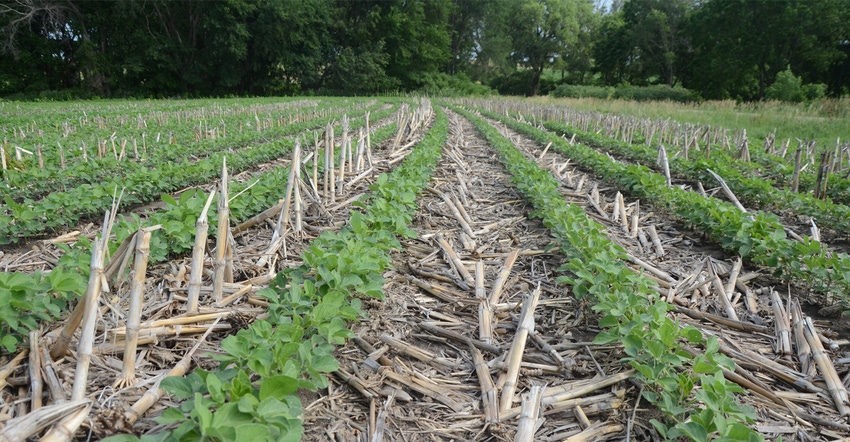November 4, 2020

Interest and concern about micronutrient needs of soybeans is common among farmers and agronomists in southeast Nebraska because of higher yields than in previous decades and the increased availability of micronutrient fertilizers in both liquid and dry formulations.
Nine micronutrients are needed in small amounts by soybeans. Micronutrients include boron, chlorine, cobalt, copper, iron, manganese, molybdenum, nickel and zinc.
Nebraska Extension educators are asking growers to take a quick two-question survey and share what micronutrients you are most concerned about on your farm for soybeans.
Soybean boron deficiencies and toxicities
In soybeans, boron is needed for cell walls during cellular expansion and normal development of nitrogen-fixing root nodules. Boron deficiencies show up at growing points because boron is not easily moved from old to new tissue. Deficiency symptoms consist of stunting, swollen nodes and the death of the growing points.
Older leaves may appear thick, dark green, leathery and cupped downward, and have delayed leaf loss or senescence in the fall. Overall, soybeans are insensitive to boron deficiency but sensitive to toxicity, including scorching or necrosis on the leaf edges.
Potential micronutrient issues are regional in nature. Boron deficiency is extremely rare in southeast Nebraska and has not been observed by University of Nebraska-Lincoln Extension to date. The closest documented boron deficiency has been with alfalfa in central Nebraska on sandy soils, but not soybeans.
In boron-sensitive crops such as alfalfa, potassium fertilization can displace calcium on the soil exchange sites, and high calcium in solution can interfere with boron absorption. Northeast Arkansas is the closest area with regular soybean boron deficiencies issues, especially when soybeans follow rice.
Soil boron availability
Soil availability of boron is greatest when the soil pH is between 5.0 and 7.0. Boron in soil solution exists as a non-ionized molecule called undissociated boric acid, which is unique among micronutrients.
Soil boron availability is controlled by adsorption or desorption on surfaces of aluminum and iron oxides, clay minerals, calcium carbonate and organic matter. Since organic matter is a large pool of potentially available boron, drought can decrease availability due to slower decomposition and less movement of boron to roots in dry soil.
Boron deficiencies in soybeans are most likely to occur on sandy soils with low organic matter. Low organic matter sandy soils are limited or make up very few acres in southeast Nebraska. However, areas and soil series names include:
• sandy alluvial soils along the Missouri River called the Sarpy soil series
• sandy glacial soils (glacial outwash deposits reworked by wind) in Gage, Johnson, and Otoe counties called the Dickinson and Filley soil series
• sandy and gravelly soils in Jefferson, Thayer, and Nuckolls counties called the Meadin and Jansen soil series
• sandy alluvial soils in Nuckolls County along the Republican River called the Inavale, McCook and Wann soil series
Soil and plant tissue testing
Soil sampling and analysis does a poor job at predicting the need for boron fertilization and poorly correlates with soybean boron uptake. As a result, it is recommended to use plant tissue nutrient analysis to determine boron sufficiency.
Soybean boron sufficiency is best determined during the beginning to full bloom stage, typically in early July. The uppermost fully expanded trifoliolate without the petiole from 30 random plants should be sent to the lab in a paper bag.
Learn more about how to conduct soybean plant tissue sampling by watching a video from 2013 created by Nebraska Extension educator Nathan Mueller.
The boron sufficiency range is 25 to 60 parts per million. If in the sufficiency range, boron is not likely a yield-limiting factor.
Boron fertilizer suggestions
The need to apply boron fertilizer to soybeans in southeast Nebraska is extremely low based on current knowledge and limited acres of low organic matter sandy soils. Boron concentrations in open lot beef manure is very low and not a major source of boron.
However, groundwater-irrigated soybean acres are receiving some boron based on past work at UNL. For example, in Saline County, 0.2 pounds of boron would be applied with 6 inches of applied groundwater based on water analysis from a well west of Wilber.
Read a recent UNL CropWatch article and view the maps of nutrient contributions by county: Crediting Essential Nutrients Applied in Irrigation Water.
Growers who are still concerned about boron are encouraged to conduct on-farm research through the UNL On-Farm Research Network.
Mueller is a Nebraska Extension educator; Lesoing is a Nebraska Extension educator; and Sindelar is a Nebraska Extension cropping systems educator.
Source: UNL CropWatch, which is solely responsible for the information provided and is wholly owned by the source. Informa Business Media and all its subsidiaries are not responsible for any of the content contained in this information asset.
You May Also Like




